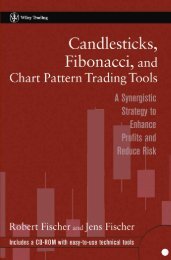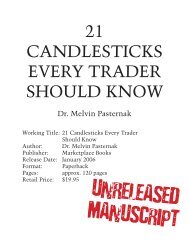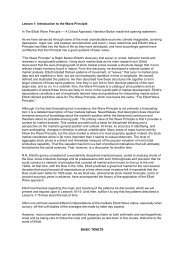The Ultimate Technical Analysis Handbook - Tradingportalen.com
The Ultimate Technical Analysis Handbook - Tradingportalen.com
The Ultimate Technical Analysis Handbook - Tradingportalen.com
You also want an ePaper? Increase the reach of your titles
YUMPU automatically turns print PDFs into web optimized ePapers that Google loves.
Chapter 1 — How the Wave Principle Can Improve Your Trading<br />
5. Provides Specific Points of Ruin<br />
At what point does a trade fail? Many traders use money management rules to determine the answer<br />
to this question, because technical studies simply don’t offer one. Yet the Wave Principle does — in<br />
the form of Elliott wave rules.<br />
Rule 1: Wave 2 can never retrace more than 100% of wave 1.<br />
Rule 2: Wave 4 may never end in the price territory of wave 1.<br />
Rule 3: Out of the three impulse waves — 1, 3 and 5 — wave 3 can never be the shortest.<br />
A violation of one or more of these rules implies that the operative wave count is incorrect. How can<br />
traders use this information? If a technical study warns of an upturn in prices, and the wave pattern is a<br />
second-wave pullback, the trader knows specifically at what point the trade will fail – a move beyond<br />
the origin of wave 1. That kind of guidance is difficult to <strong>com</strong>e by without a framework like the Wave<br />
Principle.<br />
What Trading Opportunities Does the Wave Principle Identify?<br />
Here’s where the rubber meets the road. <strong>The</strong> Wave Principle can also identify high probability trades over trade<br />
setups that traders should ignore, specifically by exploiting waves (3), (5), (A) and (C).<br />
Why? Since five-wave moves determine the direction of the larger trend, three-wave moves offer traders an<br />
opportunity to join the trend. So in Figure 3, waves (2), (4), (5) and (B) are actually setups for high probability<br />
trades in waves (3), (5), (A) and (C).<br />
For example, a wave (2) pullback provides<br />
traders an opportunity to position themselves<br />
in the direction of wave (3), just as wave (5)<br />
offers them a shorting opportunity in wave (A).<br />
By <strong>com</strong>bining the Wave Principle with traditional<br />
technical analysis, traders can improve<br />
their trading by increasing the probabilities of<br />
a successful trade.<br />
<strong>Technical</strong> studies can pick out many trading<br />
opportunities, but the Wave Principle helps<br />
traders discern which ones have the highest<br />
probability of being successful. This is because<br />
the Wave Principle is the framework that provides<br />
history, current information and a peek<br />
at the future. When traders place their technical<br />
studies within this strong framework, they<br />
have a better basis for understanding current<br />
price action.<br />
[JULY 2005]<br />
Figure 3<br />
<strong>The</strong> <strong>Ultimate</strong> <strong>Technical</strong> <strong>Analysis</strong> <strong>Handbook</strong> — © 2009 Elliott Wave International<br />
This ebook includes handpicked lessons from more than 200 pages of EWI’s <strong>com</strong>prehensive<br />
Trader’s Classroom Collection of eBooks. Learn more here: http://www.elliottwave.<strong>com</strong>/wave/ClubTCC<br />
5





